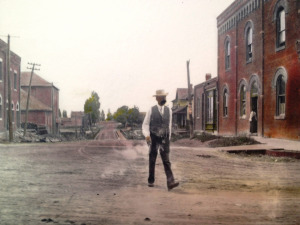 West of Collingwood at the turn of the last century, Thornbury was literally being carved out of the wilderness. This photo, circa 1899-1900, shows an unidentified man walking through what is now the intersection of Arthur Street (Hwy. 26) and Bruce Street in Thornbury. The view behind him looks east along Hwy. 26 across the Beaver River bridge. The building on the right housed Long Bros. store (now Wong’s Chinese restaurant).
West of Collingwood at the turn of the last century, Thornbury was literally being carved out of the wilderness. This photo, circa 1899-1900, shows an unidentified man walking through what is now the intersection of Arthur Street (Hwy. 26) and Bruce Street in Thornbury. The view behind him looks east along Hwy. 26 across the Beaver River bridge. The building on the right housed Long Bros. store (now Wong’s Chinese restaurant).
The building on the left was Merchant Bank (today a Century 21 real estate office). Behind the bank was the original mill owned by the Andrews brothers and adjoined by the first permanent fire hall (the peaked roof house across the road later became the site of the town’s second mill, now the Mill Café).
The Township of Thornbury was most likely named after one of four Thornburys in England. In the spring of 1833, Charles Rankin, a provincial land surveyor, had arrived to survey the “wild land beyond the Simcoe District on the shore of the Georgian Bay.” The land at that time was virgin forest, inhabited by wild animals and aboriginals from the Petun, Huron and other tribes. Rankin was instructed to set aside 900 acres of land at the mouth of the Beaver River to serve as a future town site. He built a shanty and later a log cabin on the bay and later farmed potatoes on 200 acres further west. Around 1848, Solomon Olmstead arrived from Burritts Rapids and built a small mill, a primitive dam and a home on the east bank of the Beaver River south of what is now Hwy. 26. Development quickly followed and by 1857, the population had reached the 100-person mark. Over the next 30 years, Thornbury continued to grow at a steady pace.
In 1887, feeling unfairly burdened with high taxes, the businessmen of Thornbury petitioned for independence from the Town of Collingwood. After much negotiating they were granted autonomy, and the Township of Thornbury became of the Town of Thornbury. By this time the population had blossomed to over 1,200 people and the town had clearly evolved from a backwoods wilderness to a thriving, “modern” town with its own businesses, churches, manufacturing facilities and banking institutions. ❧
Sources: Meaford Museum, Thornbury Remembered 1887-1987; A New History of Grey County; The End of An Era – Collingwood Township 1977-1997.











